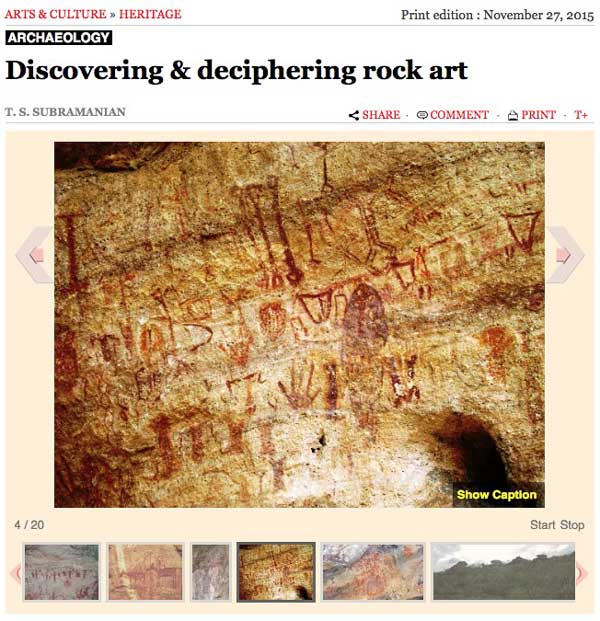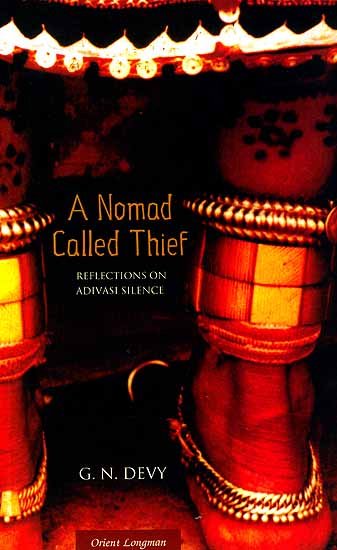
Learn more about rock art practiced by India’s tribal communities >>
“India has about 5,000 rock art sites, next only to Australia and South Africa, where prehistoric people have recorded life as they saw it, in paintings, engravings and carvings. Finding and decoding this artistic perception of reality is a challenge for rock art hunters.” – Discovering & deciphering rock art (Frontline Magazine, 27 November 2015) >>
India has about 5,000 rock art sites, next only to Australia and South Africa, where prehistoric people have recorded life as they saw it, in paintings, engravings and carvings. Finding and decoding this artistic “perception of reality” is a challenge for rock art hunters. | To view the slideshow and read the full article, click here >>
Rock art can be paintings, called petrographs, or engravings/carvings, called petroglyphs, done in rock shelters or natural caves. In recent years, cupules, that is, hollow cup-impressions created on rock surfaces using hammer stones, have also been categorised as rock art.
Source: “Discovering & deciphering rock art” by T.S. Subramanian (Frontline, 27 November 2015)
Address: https://www.frontline.in/arts-and-culture/heritage/discovering-deciphering-rock-art/article7858593.ece
Date Visited: 27 July 2020
A natural cavern with a profusion of ancient rock art, contemporary tribal paintings and even modern-day graffiti has been discovered near Mavadaippu tribal village, about 7 km from the Kadamparai hydel power station in Tamil Nadu’s Coimbatore district. | To read the full article, click here >>
K.T. Gandhirajan, art historian and explorer, P. Manivannan, K. Natarajan and a group of students from the Government College of Fine Arts, Chennai, made the discovery on May 17 [2007].
They also found about a kilometre away from the site a number of dolmens, called “muni aria” in Tamil, in four different locations in the backdrop of the Anamalai hills. […]
According to Mr. Gandhirajan, who is a post-graduate in Art History, “a spectacular feature of the site is that the rock surface is an admixture of ancient rock art and contemporary tribal paintings, showing continuity of tradition as it were.”
The paintings have been done on a rock surface that is 40 feet long and 20 feet tall. He and other experts put the date of the ancient rock paintings around 1500 B.C. These paintings include a tiger with its mouth wide open, a deer with straight horns, a porcupine, a wild boar, a peacock and elephants.
There are paintings of marching men in anthropomorphic form within a circle.
Below are also men in marching form but not within a circle. There are scenes of an unidentified animal chasing another, an elephant seizing a man with its trunk with another man running after the elephant, etc.
Human figures are aplenty, showing men fighting and dancing. A rare painting has a man in profile, with a peculiar headgear. There is a glut of “mystic” designs and ancient graffiti. A leit motif is the figure of a ladder made out of bamboo poles. Such ladders are used even now to extract honey from beehives situated at heights near the tribal villages. Mr. Gandhirajan said: “Constructing these bamboo-ladders is an architecture itself. Building them is a secret. It is done only at night. Non-community people will not be allowed to be present when tribals build them. These ladders can be sometimes 200 feet tall.” The contemporary tribal paintings show a man wearing a tight coat that has rectangular designs on it. He is seen with a raised right hand and his left hand on the waist.
A drawing of a bus indicates how the arrival of a bus there could be an exciting event. The ancient rock art had been drawn using lime, white kaolin and even ash.
Recently, tribals had used enamel to embellish some of these ancient paintings.

Reflections on Adivasi Silence and Voice by Ganesh [G.N.] Devy | Publications >>
It was both on cue and by accident that the group headed by Mr. Gandhirajan discovered this site. The group had gone to Puliyankandi village near the Aliyar reservoir to conduct a workshop for children belonging to local tribes on art and heritage and rock art sites found nearby. When the children were asked whether they knew of cave paintings, a girl told them that she had seen paintings of elephants on a massive boulder near her village but she could not give the exact location. […]
Tribals believe that the dolmens with compartments were meant for chieftains of yore. The centrepiece is a big dolmen that has a short “compound wall” running around the wall is made of stones with packing.
Source: “Ancient rock art dating back to 1500 B.C. found in Tamil Nadu” by T.S. Subramanian (The Hindu, 27, 2007 / Updated: September 28, 2016)
Address: https://www.thehindu.com/todays-paper/tp-national/Ancient-rock-art-dating-back-to-1500-B.C.-found-in-Tamil-Nadu/article14769223.ece
Date Visited: 27 July 2020
Rock art is a term used to define several types of artistic examples in the form of paintings, bruising, pecking, and engravings etc; in the bare rock surfaces of caves, rock shelters and isolated rock boulders, executed by our ancestors. Basically there are two types of rock art. One of them is produced by an “additive process”, i.e. by adding some colour substance to the rock surface to depict motifs, figures etc. This form of art is variously known as pictographs, petrographs, paintings etc. Since majority of this form of rock art occurs in caves and rock shelters and which cannot be moved from place to place, it is also known as ‘parietal art’. The second form of art is produced by a ‘deductive process” i.e., by removing rock particles from the rock with the help of a sharp instruments, of stone or metal, to depict the desired figure, motif or symbol. This form of art is known in various forms depending on the technique of execution, as petroglyphs, engravings and bruising.
Rock art is a global phenomenon with its antiquity going back to more than forty thousands of years, when men’s subsistence economy was based on hunting and gathering. In the history of mankind no work of fine art other than rock art has such a wide distribution lasting for such a long time. […]
India is one of the three countries with largest concentration of the world heritage of rock art, the other two being Australia and South Africa. It is also significant to note that India pioneered rock art research in the world. […]
In the last two decades [preceding 2008] a host of scholars like; Y. Mathapal (1984, 1995,1998), Giriraj Kumar (1984), V. H. Sonawane (1984,1996), K. K. Chakravorty (1984), Rakesh Tiwari (1990), Erwin Neumayer (1993), R. K.Sharma and K. K. Tripathy (1996), Somnath Chakraverty (1996), Murari Lai Sharma(1996), K. K. Chakravorty and R.G.Bedrarik (1997) N. Chandramouli (1991, 1995) S. Pradhan (1988 1994, 1995, 1996, 2001,2002) have substantially contributed in bringing to limelight new rock art sites and in furthering the rock art research in India. […]
Source: “Introduction to Rock Art in India” by Kunja Bihari Barik (PhD thesis titled “Rock art in Orissa an ethnoarchaeological study” 2008, p. 2)
URL: https://shodhganga.inflibnet.ac.in/handle/10603/202775
Date Visited: 27 July 2020
[Bold typeface added above for emphasis]
Photo and video recommendation: a voice from rural India worth being heard
Whether you plan a visit or seek to learn more about India’s rural life – perhaps inspired by the Gandhian social movement or Rabindranath Tagore – explore “a living journal, a breathing archive” in the Adivasi category of PARI: the People’s Archive of Rural India initiated by distinguished photo journalist-turned-activist P. Sainath, continually enriched by stories from all over India.
“In less than 200 years, photography has gone from an expensive, complex process to an ordinary part of everyday life. From selfies to satellites, most of the technology we use and spaces we inhabit rely on cameras. […] While photographic documentation can aid in shaping history, it can also be a window into the horrors of the past.” – Read more or listen to Butterfly Effect 9 – The Camera on CBC Radio Spark 26 May 2023 >>
Find scholarly books, poetry and fiction relating to tribal culture – Indian publishers
List of sites covered by this Google custom search engine
To find children’s and educational books or search Indian periodicals, magazines, web portals and other sources safely, click here >>
Search tips
Combine the name of any particular state, language or region with that of any tribal (Adivasi) community.
Add keywords of special interest (music, poetry, dance just as health, sacred grove and biodiversity); learn about the rights of Scheduled Tribes such as the “Forest Rights Act” (FRA); and the United Nations “Declaration on the Rights of Indigenous Peoples”, “Universal Declaration of Human Rights”, “women’s rights”, or “children’s right to education”.
Specify any other issue or news item you want to learn more about (biodiversity, bonded labour and human trafficking, climate change, ecology, economic development, ethnobotany, ethnomedicine, global warming, hunter-gatherers in a particular region or state, prevention of rural poverty, water access).
For official figures include “scheduled tribe ST” along with a union state or region: e.g. “Chhattisgarh ST community”, “Himalayan tribe”, “Scheduled tribe Tamil Nadu census”, “ST Kerala census”, “Particularly Vulnerable Tribal Group Jharkhand”, “PVTG Rajasthan”, “Adivasi ST Kerala”, “Adibasi ST West Bengal” etc.
In case the Google Custom Search window is not displayed here try the following: (1) toggle between “Reader” and regular viewing; (2) in your browser’s Security settings select “Enable JavaScript” | More tips >>
Note: hyperlinks and quotes are meant for fact-checking and information purposes only | Disclaimer >>
See also
eBook | Background guide for education
Health and nutrition | Recommendations by the Expert Committee